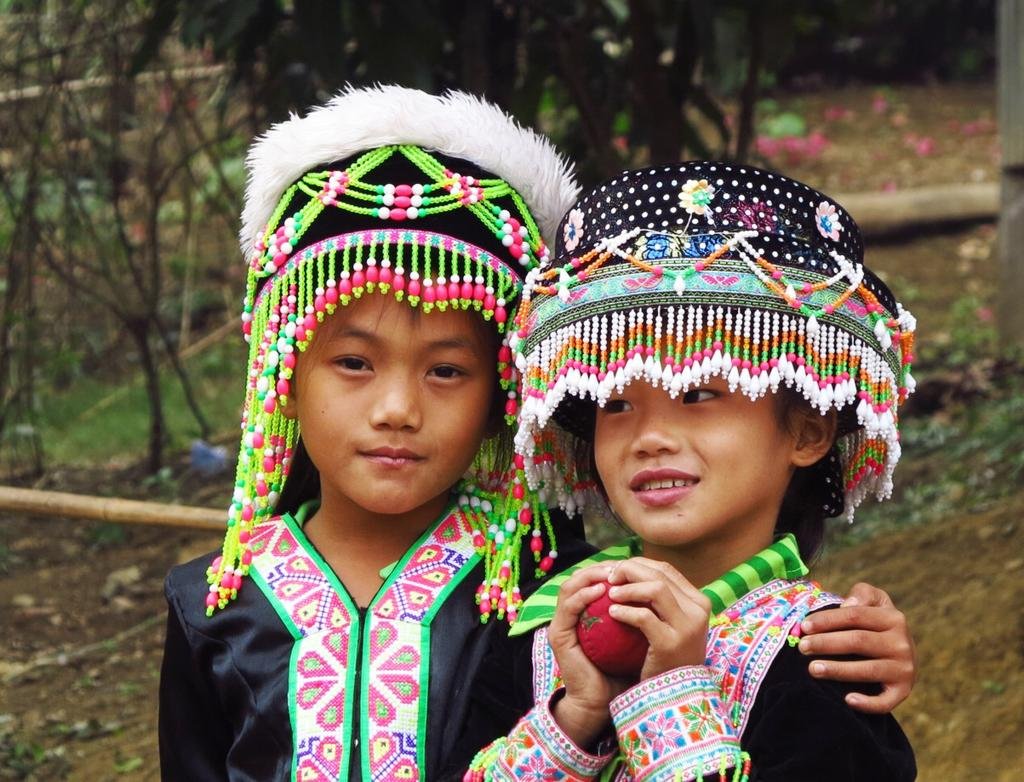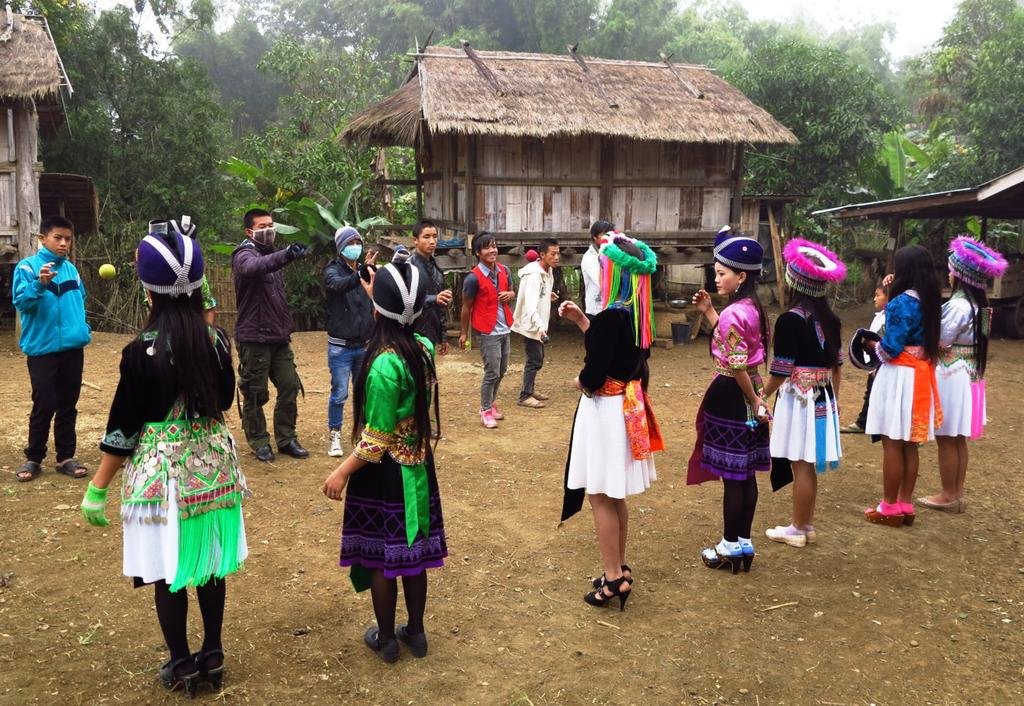KTMphil
Senior member
R 2W, north east of Pakbeng, Laos, Hmong new year celebrations were underway this week after the harvest

[h=2]Hmong New Year[/h]The Hmong New Year celebration is a cultural tradition that takes place annually in select areas where large Hmong communities exist and in a modified form where smaller communities come together. During the New Year's celebration, Hmong dress in traditional clothing and enjoy Hmong traditional foods, dance, music, bull fights, and other forms of entertainment. Hmong New Year celebrations have Hmong ethnic traditions and culture, and may also serve to educate those who have interest in Hmong tradition. Hmong New Year celebrations frequently occur in November and December (traditionally at the end of the harvest season when all work is done), serving as a Thanksgiving holiday for the Hmong people.
Historically, the Hmong New Year celebration was created to give thanks to ancestors and spirits as well as to welcome in a new beginning. Traditionally, the celebration lasts for ten days, has been shortened in America due to the difference between the traditional Hmong farming schedule and that of the American 40-hr work week schedule. It has also served the double purpose of a convenient meeting place and time for the Hmong leadership, from the days of China even until now.
During the Hmong New Year celebration, the Hmong ball tossing game pov pob is a common activity for adolescents. Boys and girls form two separate lines in pairs that are directly facing one another. Girls can ball toss with other girls or boys, but boys cannot ball toss with other boys. It is also taboo to toss the ball to someone of the same clan and date the same clan. The pairs toss a cloth ball back and forth, until one member drops the ball. If a player drops or misses the ball, an ornament or item is given to the opposite player in the pair. Ornaments are recovered by singing love songs (hais kwv txhiaj) to the opposite player.[1] but in recent times, in such areas as China, the young lovers have been seen to carry tape players to play their favorite love songs for one another.
The Hmong New Year celebration—specifically based on both religious and cultural beliefs—is an “in-house” ritual that takes place annually in every Hmong household. The celebration is to acknowledge the completion of the rice-harvesting season—thus, the beginning of a new year—so that a new life can begin as the cycle of life continues. During this celebration, every "wandering" soul of every family member is called back to unite with the family again and the young will honor the old or the in-laws—a ritual of asking for blessings from elders of the house and clan as well as the in-laws of other clans.
Also, during the Hmong New Year celebration, house spirits as well as the spirit of wealth (xim kaab) are honored. In addition, if a shaman is in the house, the healing spirits of She-Yee are also honored and released to wander the land (Neeb Foob Yeem)—similar to vacationing after a long year of working—until they are called back right after new year. Hmong New Year lasts only for 3 days—with 10 dishes of food each day, for a total of 30 dishes—thus the Hmong saying “eat 30.” Here are a few practices that the Hmong observe during their New Year Celebration, performed anytime during the 3 days of celebration.
During the Tsa Hauv Toj celebration, Hmong dress in traditional clothing and enjoy Hmong traditional foods, dance, music, bull fights, and other forms of entertainment. Hmong New Year celebrations preserve Hmong ethnic traditions and culture, and may also serve to educate those who are interested in Hmong tradition. Hmong New Year celebrations occurred anytime within or close to the end of the harvesting period give or take a few days. However, the Tsa Hauv Toj event is based on lunar calendar, typically in November and December (which would consider a month ahead of western calendar).


[h=2]Hmong New Year[/h]The Hmong New Year celebration is a cultural tradition that takes place annually in select areas where large Hmong communities exist and in a modified form where smaller communities come together. During the New Year's celebration, Hmong dress in traditional clothing and enjoy Hmong traditional foods, dance, music, bull fights, and other forms of entertainment. Hmong New Year celebrations have Hmong ethnic traditions and culture, and may also serve to educate those who have interest in Hmong tradition. Hmong New Year celebrations frequently occur in November and December (traditionally at the end of the harvest season when all work is done), serving as a Thanksgiving holiday for the Hmong people.
Historically, the Hmong New Year celebration was created to give thanks to ancestors and spirits as well as to welcome in a new beginning. Traditionally, the celebration lasts for ten days, has been shortened in America due to the difference between the traditional Hmong farming schedule and that of the American 40-hr work week schedule. It has also served the double purpose of a convenient meeting place and time for the Hmong leadership, from the days of China even until now.
During the Hmong New Year celebration, the Hmong ball tossing game pov pob is a common activity for adolescents. Boys and girls form two separate lines in pairs that are directly facing one another. Girls can ball toss with other girls or boys, but boys cannot ball toss with other boys. It is also taboo to toss the ball to someone of the same clan and date the same clan. The pairs toss a cloth ball back and forth, until one member drops the ball. If a player drops or misses the ball, an ornament or item is given to the opposite player in the pair. Ornaments are recovered by singing love songs (hais kwv txhiaj) to the opposite player.[1] but in recent times, in such areas as China, the young lovers have been seen to carry tape players to play their favorite love songs for one another.
The Hmong New Year celebration—specifically based on both religious and cultural beliefs—is an “in-house” ritual that takes place annually in every Hmong household. The celebration is to acknowledge the completion of the rice-harvesting season—thus, the beginning of a new year—so that a new life can begin as the cycle of life continues. During this celebration, every "wandering" soul of every family member is called back to unite with the family again and the young will honor the old or the in-laws—a ritual of asking for blessings from elders of the house and clan as well as the in-laws of other clans.
Also, during the Hmong New Year celebration, house spirits as well as the spirit of wealth (xim kaab) are honored. In addition, if a shaman is in the house, the healing spirits of She-Yee are also honored and released to wander the land (Neeb Foob Yeem)—similar to vacationing after a long year of working—until they are called back right after new year. Hmong New Year lasts only for 3 days—with 10 dishes of food each day, for a total of 30 dishes—thus the Hmong saying “eat 30.” Here are a few practices that the Hmong observe during their New Year Celebration, performed anytime during the 3 days of celebration.
- Hu Plig (Soul Calling)—Calling back every soul in the family to unite with the family
- Txi Xim Kaab (Honoring Xim Kaab)—Offerings to the God of Wealth
- Neeb Foob Yeem—Shamanistic Ritual to release the Curing spirits of She-Yee for “vacationing"—occurs only if the specific family has a shaman in the house
- Noj 30 (Eat 30)—The main meal of New year
- Pe Tsab (Asking for Blessings from Elders)—Occurred early morning during New Year’s day, including parents, uncles, father/moth-in-law, and dead ancestors
- Ntxuav Kauv Laug (Cleaning the Body)—To cleanse the body of dirtiness
- Ntuag Qhauv—A ritual to get rid of problems, issues, temper, loneliness, and all the bad things which have occurred in the household
- Lwm Qab/Sub—Using a chicken, a ritual also
- Tog NeejTsa Tuaj Noj Tsab—Request special guests (such as father in law, son in law etc.) to come “eat Tsab,” a very big “eat 30.
- Xa Noob Ncoos/Tsoog Laug—A very special “thanksgiving” event where parents and in-laws are honored
- Tam Noob Ncoos—A thank you feast from parents and in-laws
- Tso Plig—To release the souls of all dead ones
- Noj Tsab (eat tsab)—a very big “eat 30,” involving pigs, cows, and buffalo.
During the Tsa Hauv Toj celebration, Hmong dress in traditional clothing and enjoy Hmong traditional foods, dance, music, bull fights, and other forms of entertainment. Hmong New Year celebrations preserve Hmong ethnic traditions and culture, and may also serve to educate those who are interested in Hmong tradition. Hmong New Year celebrations occurred anytime within or close to the end of the harvesting period give or take a few days. However, the Tsa Hauv Toj event is based on lunar calendar, typically in November and December (which would consider a month ahead of western calendar).












































